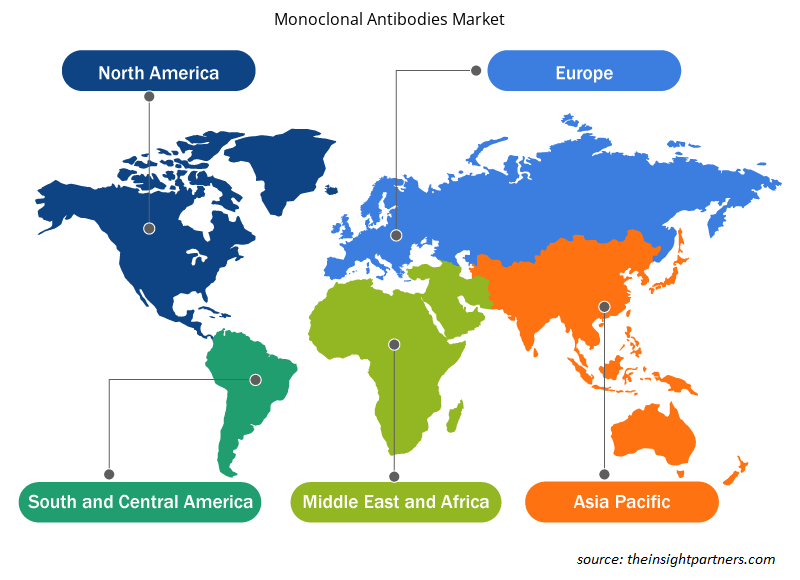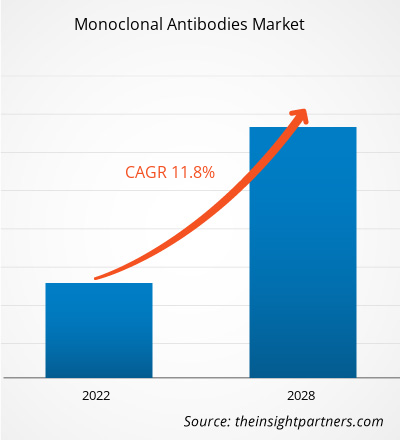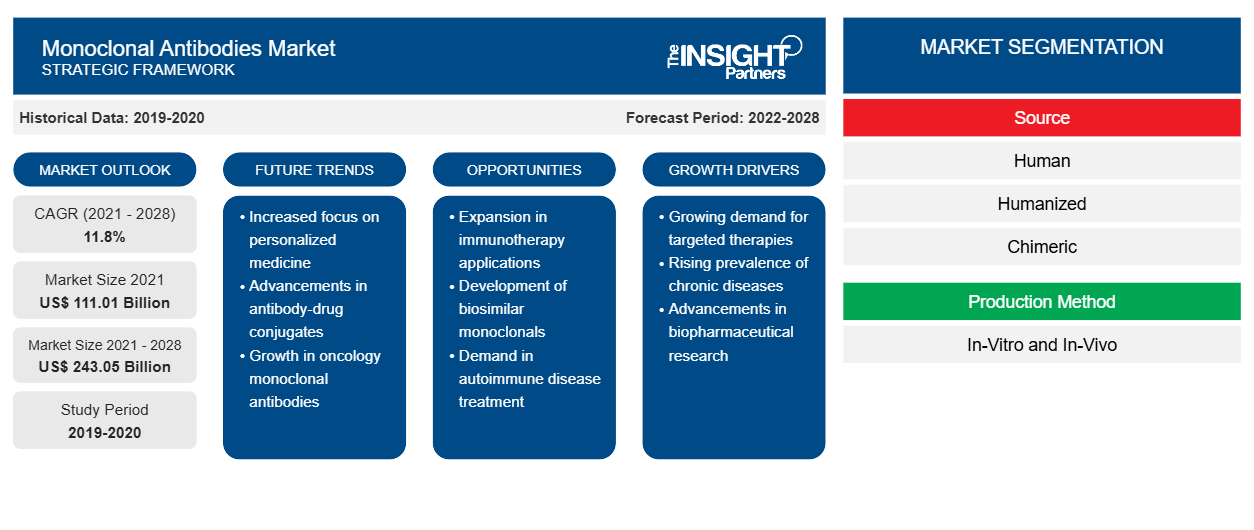Le marché des anticorps monoclonaux devrait atteindre 243,05 milliards de dollars américains d'ici 2028, contre 111,01 milliards de dollars américains en 2021 ; il devrait croître à un TCAC de 11,8 % de 2021 à 2028.TCAC de 11,8 % de 2021 à 2028.
La prévalence croissante du cancer et d'autres maladies chroniques, ainsi que l'augmentation considérable des cas de COVID-19 dans diverses régions sont les principaux facteurs qui alimentent la croissance du marché. Selon le World Cancer Research Fund et l'American Institute for Cancer, en 2020, environ 18,1 millions de cas de cancer ont été enregistrés, dont 9,3 millions chez les hommes et 8,8 millions chez les femmes. L'utilisation d'anticorps monoclonaux dans le traitement de divers types de cancer en est encore aux essais de phase 2 et de phase 3.
L'Amérique du Nord devrait continuer à dominer le marché des anticorps monoclonaux au cours de la période 2021-2028. Les États-Unis détiennent la plus grande part du marché dans cette région et devraient continuer à être un actionnaire dominant du marché au cours de la période de prévision. Selon les statistiques publiées par Globocan 2020, environ 1 806 590 nouveaux cas de cancer ont été diagnostiqués aux États-Unis et environ 606 520 personnes sont décédées des suites de cette maladie. Selon un rapport du ministère américain du Commerce, son National Institute of Standards and Technology (NIST) a annoncé le financement de 153 millions de dollars américains au National Institute for Innovation in Manufacturing Biopharmaceuticals. En outre, la FDA a étendu son soutien au développement d'anticorps monoclonaux pendant la prévalence du COVID-19.En 2020, environ 1 806 590 nouveaux cas de cancer ont été diagnostiqués aux États-Unis et environ 606 520 personnes sont décédées des suites de cette maladie. Selon un rapport du ministère américain du Commerce, son National Institute of Standards and Technology ( NIST ) a annoncé le financement de 153 millions de dollars américains au National Institute for Innovation in Manufacturing Biopharmaceuticals . En outre, la FDA a étendu son soutien au développement d'anticorps monoclonaux pendant la pandémie de COVID-19.
Personnalisez ce rapport en fonction de vos besoins
Vous bénéficierez d'une personnalisation gratuite de n'importe quel rapport, y compris de certaines parties de ce rapport, d'une analyse au niveau des pays, d'un pack de données Excel, ainsi que d'offres et de remises exceptionnelles pour les start-ups et les universités.
- Obtenez les principales tendances clés du marché de ce rapport.Cet échantillon GRATUIT comprendra une analyse de données, allant des tendances du marché aux estimations et prévisions.
Informations sur le marché
L'augmentation significative de la prévalence du cancer et d'autres maladies chroniques stimule la croissance du marché
Selon le rapport de l'American Cancer Society, environ 16,9 millions de personnes ayant des antécédents de cancer résidaient aux États-Unis en janvier 2019. D'ici janvier 2030, la population de survivants du cancer devrait atteindre 22,1 millions en raison de la croissance et du vieillissement de la population. Par conséquent, avec la prévalence croissante du cancer et d'autres maladies chroniques, la demande de produits biologiques, tels que les anticorps monoclonaux (mAB), a également augmenté. En tant que composants principaux de nombreux schémas thérapeutiques et traitements rentables, les produits biologiques jouent un rôle clé dans le traitement du cancer.
Informations basées sur des sources
Selon la source, le marché des anticorps monoclonaux est segmenté en murin, chimérique, humain et humanisé. Le segment humain devrait représenter la plus grande part de marché au cours de la période 2021-2028. La croissance du marché de ce segment est attribuée à la hausse due à l'intégration d'anticorps monoclonaux humains pour le traitement de divers types de maladies infectieuses . Par exemple, Regeneron a lancé un cocktail d'anticorps approuvé par la FDA, casirivimab et imdevimab, pour une utilisation dans le COVID-19. Le médicament a reçu une autorisation d'utilisation d'urgence (EUA) de la FDA. Il est utilisé pour le traitement du COVID-19 léger à modéré chez les adultes ainsi que chez les patients pédiatriques âgés d'au moins 12 ans et pesant au moins 40 kg. De plus, l'augmentation de leur utilisation dans diverses maladies chroniques et l'emploi de technologies avancées de génie génétique comptent parmi les facteurs importants qui stimulent la croissance du segment de marché.
Informations basées sur des indications
Selon les indications, le cancer, les maladies auto-immunes, les maladies inflammatoires , les maladies infectieuses, les maladies microbiennes et autres. Le segment du cancer dominera le marché dans les années à venir. Les progrès liés à l'application thérapeutique des anticorps monoclonaux ont permis leur mise en œuvre réussie dans les traitements de divers types de cancer, tels que le cancer du sein, le cancer du poumon et le cancer du côlon. Les médicaments à base de ces anticorps aident à signaler les cellules cancéreuses, à déclencher la destruction de la membrane cellulaire, à bloquer les inhibiteurs du système immunitaire, etc. En juin 2020, la FDA a approuvé deux médicaments, l'olaparib et le rucaparib, pour le traitement du cancer de la prostate. Le médicament est particulièrement efficace chez les hommes atteints de cancer de la prostate qui se sont propagés ou métastasés et qui ne répondent plus aux traitements hormonaux standard, c'est-à-dire les maladies résistantes à la castration.
Informations basées sur l'utilisateur final
Le marché des anticorps monoclonaux est segmenté en fonction de l'utilisateur final : hôpitaux, instituts de recherche et autres. Le segment hospitalier détient la plus grande part de marché en raison de l'adoption croissante des mAB comme ligne de traitement privilégiée, en particulier pour le traitement du cancer.
Les entreprises opérant sur le marché des anticorps monoclonaux adoptent la stratégie d’innovation produit pour répondre aux demandes évolutives des clients à travers le monde, ce qui leur permet également de maintenir leur nom de marque sur le marché mondial.
Aperçu régional du marché des anticorps monoclonaux
Les tendances régionales et les facteurs influençant le marché des anticorps monoclonaux tout au long de la période de prévision ont été expliqués en détail par les analystes d’Insight Partners. Cette section traite également des segments et de la géographie du marché des anticorps monoclonaux en Amérique du Nord, en Europe, en Asie-Pacifique, au Moyen-Orient et en Afrique, ainsi qu’en Amérique du Sud et en Amérique centrale.

- Obtenez les données régionales spécifiques au marché des anticorps monoclonaux
Portée du rapport sur le marché des anticorps monoclonaux
| Attribut de rapport | Détails |
|---|---|
| Taille du marché en 2021 | 111,01 milliards de dollars américains |
| Taille du marché d'ici 2028 | 243,05 milliards de dollars américains |
| Taux de croissance annuel moyen mondial (2021-2028) | 11,8% |
| Données historiques | 2019-2020 |
| Période de prévision | 2022-2028 |
| Segments couverts | Par source
|
| Régions et pays couverts | Amérique du Nord
|
| Leaders du marché et profils d'entreprises clés |
|
Densité des acteurs du marché des anticorps monoclonaux : comprendre son impact sur la dynamique commerciale
Le marché des anticorps monoclonaux connaît une croissance rapide, tirée par la demande croissante des utilisateurs finaux en raison de facteurs tels que l'évolution des préférences des consommateurs, les avancées technologiques et une plus grande sensibilisation aux avantages du produit. À mesure que la demande augmente, les entreprises élargissent leurs offres, innovent pour répondre aux besoins des consommateurs et capitalisent sur les tendances émergentes, ce qui alimente davantage la croissance du marché.
La densité des acteurs du marché fait référence à la répartition des entreprises ou des sociétés opérant sur un marché ou un secteur particulier. Elle indique le nombre de concurrents (acteurs du marché) présents sur un marché donné par rapport à sa taille ou à sa valeur marchande totale.
Les principales entreprises opérant sur le marché des anticorps monoclonaux sont :
- Novartis SA
- Pfizer Inc.
- GlaxoSmithKline plc
- Amgen, Inc
- Société Daiichi Sankyo, Limitée
Avis de non-responsabilité : les sociétés répertoriées ci-dessus ne sont pas classées dans un ordre particulier.

- Obtenez un aperçu des principaux acteurs du marché des anticorps monoclonaux
Marché des anticorps monoclonaux – Segmentation
Selon la source, le marché des anticorps monoclonaux est segmenté en humains, humanisés, chimériques et murins. Selon la méthode de production, le marché est segmenté en in vitro et in vivo. Le marché des anticorps monoclonaux, par indication, est en outre segmenté en cancer, maladies auto-immunes, maladies infectieuses, maladies inflammatoires, maladies microbiennes et autres. Par application, le marché est sous-segmenté en applications thérapeutiques, applications diagnostiques et applications de recherche. De plus, en fonction de l'utilisateur final, le marché est segmenté en hôpitaux, autres et instituts de recherche.
Marché des anticorps monoclonaux – par géographie
- Amérique du Nord
- NOUS
- Canada
- Mexique
- Europe
- France
- Allemagne
- Italie
- ROYAUME-UNI
- Espagne
- Reste de l'Europe
- Asie-Pacifique (APAC)
- Chine
- Inde
- Corée du Sud
- Japon
- Australie
- Reste de l'APAC
- Moyen-Orient et Afrique (MEA)
- Afrique du Sud
- Arabie Saoudite
- Émirats arabes unis
- Reste de la MEA
- Amérique du Sud et Amérique centrale (SCAM)
- Brésil
- Argentine
- Reste de SCAM
Profils d'entreprise
- Novartis SA
- Pfizer Inc.
- GlaxoSmithKline plc
- Amgen, Inc
- Société Daiichi Sankyo, Limitée
- F. Hoffmann-La Roche AG
- AstraZeneca
- Elli Lily et compagnie
- Bayer AG
- Société Bristol-Myers Squibb
- Analyse historique (2 ans), année de base, prévision (7 ans) avec TCAC
- Analyse PEST et SWOT
- Taille du marché Valeur / Volume - Mondial, Régional, Pays
- Industrie et paysage concurrentiel
- Ensemble de données Excel
Rapports récents
Témoignages
Raison d'acheter
- Prise de décision éclairée
- Compréhension de la dynamique du marché
- Analyse concurrentielle
- Connaissances clients
- Prévisions de marché
- Atténuation des risques
- Planification stratégique
- Justification des investissements
- Identification des marchés émergents
- Amélioration des stratégies marketing
- Amélioration de l'efficacité opérationnelle
- Alignement sur les tendances réglementaires





















 Obtenez un échantillon gratuit pour - Marché des anticorps monoclonaux
Obtenez un échantillon gratuit pour - Marché des anticorps monoclonaux